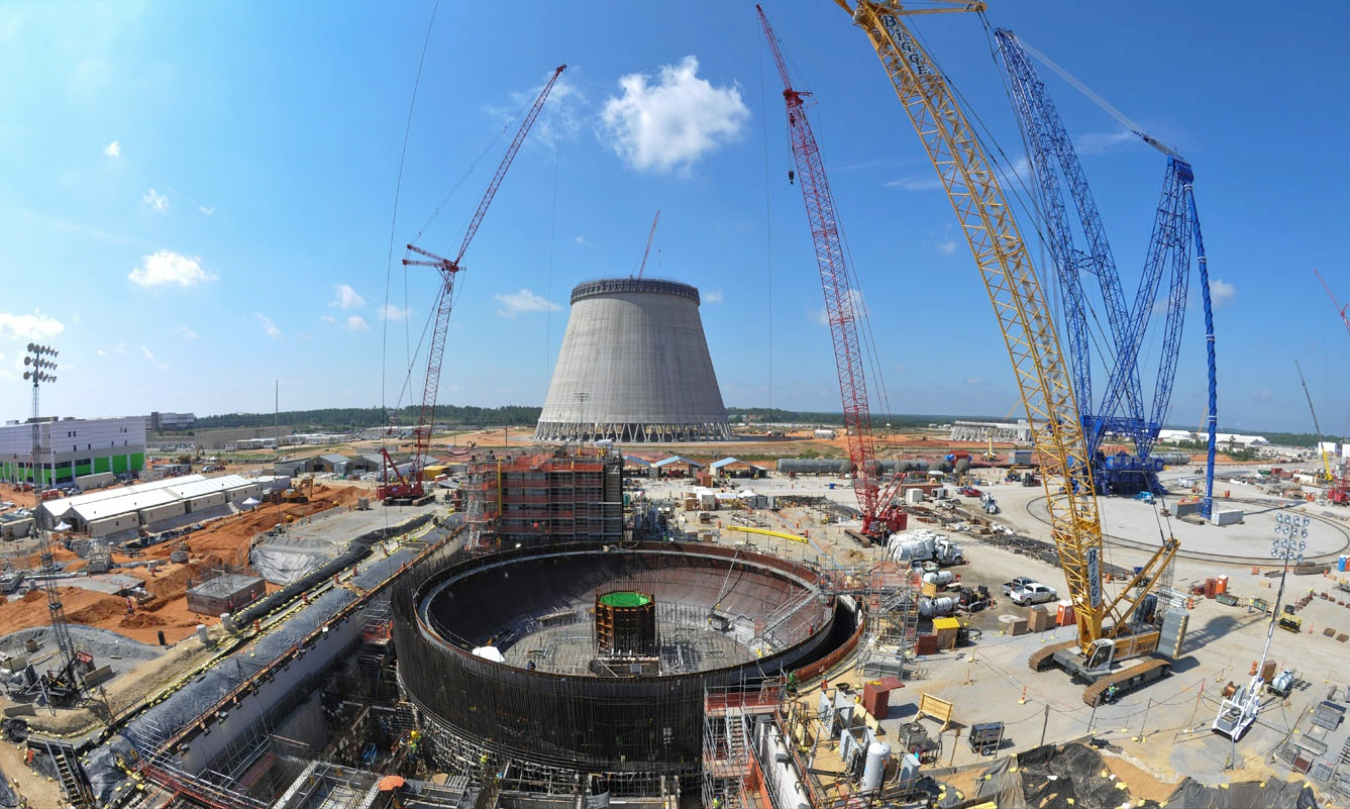
This morning, the Department announced that it is making $12.5 billion in loan guarantees available for Advanced Nuclear Energy Projects. My colleagues in the Loan Programs Office (LPO) and I are following up on this announcement by discussing the role loan guarantees can play in helping to build a strong U.S. nuclear power industry for the future before a gathering of industry professionals at the Nuclear Power International conference.
One area we intend to review is how LPO helped to finance the construction of the first new nuclear reactors in the U.S. in more than 30 years at Georgia’s Plant Vogtle. By committing $8.3 billion in loan guarantees for the project, LPO is helping to revitalize the U.S. nuclear industry, which has the potential to play a large role in meeting our future low-carbon energy goals.
We also will discuss the types of advanced nuclear energy technologies that have been identified in the solicitation as key areas of interest. While any technology that meets the eligibility requirements is welcome to apply, these four areas are of particular interest:
- Advanced Nuclear Reactors: This area focuses on nuclear energy projects with evolutionary, state-of-the-art design improvements in the areas of fuel technology, thermal efficiency, modularized construction, safety systems, and standardized design.
- Small Modular Reactors (SMRs): This area focuses on innovative technologies for nuclear energy projects that are nominally 300 MWe or smaller in size.
- Uprates and Upgrades at Existing Facilities: This area focuses on projects that use an innovative technology to improve an existing reactor by increasing efficiency, increasing capacity or making critical improvements that are integral to current or future facility operations.
- Front-End Nuclear: This area focuses on advanced nuclear facilities for the “front-end” of the nuclear fuel cycle. Of the $12.5 billion available under this solicitation, $2 billion is available exclusively for “front-end” projects. This could include uranium conversion or enrichment, as well as nuclear fuel fabrication.
Over the past 12 months, LPO has also issued an $8 billion Advanced Fossil Energy Projects Solicitation and a $4 billion Renewable Energy and Efficient Energy Projects Solicitation. Now, LPO can issue new loan guarantees for all of the clean energy technology areas for which it has loan authority under Title XVII.
With the amounts available for loan guarantees for innovative clean energy added to the $16 billion Advanced Technology Vehicle Manufacturing Loan Program, LPO has $40 billion available to advance America’s all-of-the-above energy strategy. In leveraging LPO’s remaining authority, we hope to replicate the success of our current portfolio of loans, loan guarantees, and commitments to some of the most innovative clean energy and vehicle manufacturing projects operating in the world today. By doing so, we will build a diverse portfolio that supports new industries and moves us closer to a low-carbon energy future.
Title XVII Open Solicitations
INNOVATIVE ENERGY AND INNOVATIVE SUPPLY CHAIN
Title 17 Clean Energy Financing – Innovative Energy and Innovative Supply Chain
Financing for projects that:
Deploy innovative clean energy technologies at commercial scale (Innovative Energy)
Or
Employ innovative manufacturing processes or manufacture innovative technologies at commercial scale (Innovative Supply Chain)
Overview
Through the Innovative categories of the Title 17 Clean Energy Financing Program, LPO can finance projects that deploy new or significantly improved high-impact clean energy technology (Innovative Energy) or that employ new or significantly improved technology in the manufacturing process for a qualifying clean energy technology or manufacture innovative products with an eligible technology end-use (Innovative Supply Chain).
LPO-financed projects show private debt and equity investors that innovative clean energy technologies are bankable and ready for large-scale deployment. LPO has a strong track record of catalyzing clean energy deployment, having financed the first utility-scale photovoltaic solar projects in the United States, one of the world’s largest wind projects, the next generation of advanced nuclear reactors, and the nation’s first clean hydrogen energy and storage project.
Like commercial lenders and other private capital market lenders, LPO underwrites loans with the expectation that they will be repaid with interest. Unlike most lenders, LPO has in-house technical experts who work with applicants to understand the project’s true technical risks. From there, LPO’s credit, market, environmental, and legal professionals work with applicants to structure loan terms accordingly. The result is often access to lower-interest loans than would otherwise be available. The early deployments LPO finances de-risk follow-on deployments.
LPO engages early with applicants and offers flexible financing that private lenders typically do not provide for projects developing innovative components for the low-carbon supply chain. By doing so, LPO can jumpstart production and minimize future supply chain bottlenecks for innovative clean energy technologies.
Defining “Innovative”
LPO considers projects innovative if they employ a New or Significantly Improved Technology. (See page 15 of the Program Guidance or the Title 17 Interim Final Rule for a definition of New or Significantly Improved Technology.)
New or Significantly Improved Technology refers to technologies concerned with the production, consumption, storage, or transportation of energy, including of associated critical minerals and other components or other eligible energy-related project categories, and that is not a commercial technology, and that either:
- Has only recently been developed, discovered, or learned; or
- Involves or constitutes one or more meaningful and important improvements in productivity or value, in comparison to commercial technologies used in the United States.
When evaluating whether a technology is “New or Significantly Improved,” LPO will consider whether the technology could have a catalytic effect on the market and whether the technology has the potential to be employed in other commercial projects.
Eligibility
In addition to the common eligibility requirements that apply to all Title 17 Clean Energy Financing Program projects, Innovative Energy and Innovative Supply Chain projects must meet several additional eligibility criteria.
All Innovative projects must align with one of the following eligible technologies:
- Advanced nuclear energy
- Efficient electrical generation, transmission, and distribution
- Supply of critical minerals
- Carbon capture and sequestration technologies
- Advanced fossil energy technology
- Oil refineries
- Energy storage technologies
- Production facilities for the manufacture of fuel-efficient vehicles or parts of those vehicles
- Renewable energy systems
- Industrial decarbonization technologies
- Hydrogen fuel cell technology
- Pollution control equipment
- Efficient end-use energy technologies
Innovative Energy-Specific Requirements
- Projects must include a New or Significantly Improved Technology applied to one or more of the eligible technologies.
Innovative Supply Chain-Specific Requirements
-
Projects must either employ a New or Significantly Improved Technology in the manufacturing process for an eligible technology or manufacture a component that represents an eligible New or Significantly Improved Technology.
-
Projects must avoid, reduce, utilize, or sequester air pollutants or anthropogenic emissions of greenhouse gases through (1) the manufacturing process of the relevant product or (2) the end-use of the component on a full life-cycle basis.
Possible Project Areas
The following is a set of project types that could be eligible for Innovative Energy financing, subject to LPO review. These examples are neither exhaustive nor limiting.
The following is a set of project types that could be eligible for Innovative Energy financing, subject to LPO review. These examples are neither exhaustive nor limiting.
- Distributed solar and storage (virtual power plant)
- Distributed demand response (virtual power plant)
- Offshore wind
- Stationary and/or mobile energy storage
- HVDC transmission
- Small modular reactor (SMR) nuclear
- "Front-end" nuclear fuel cycle
- Advanced nuclear reactors
- Nuclear uprates or upgrades
- Advanced geothermal
- Carbon capture, utilization, and storage (CCUS)
- Hydrogen production and infrastructure
- Sustainable aviation fuels, biofuels
- Alternative vehicle fuel distribution facilities (e.g., hydrogen, LNG, CNG)
The following is a set of project types that could be eligible for Innovative Supply Chain financing, subject to LPO review. These examples are neither exhaustive nor limiting.
- Solar supply chain components
- Low-carbon cement, steel, or iron
- Onshore and/or offshore wind components
- Small modular reactors and micro reactors
- Advanced nuclear components
- Critical minerals (including processing, manufacturing, and recycling of mineral alternatives)
- Electric vehicle charging infrastructure
- Electric grid components
- Low-carbon pulp and paper
- Low-carbon chemicals
- Low-carbon aluminum
- Electrolyzer manufacturing
Additional program details and application requirements are described in the Title 17 Clean Energy Financing Program Guidance and on the Title 17 Overview web page.
Next Steps
If you have a project that may be eligible for financing through the Innovative Energy or Innovative Supply Chain project categories, please request a no-cost pre-application consultation.


